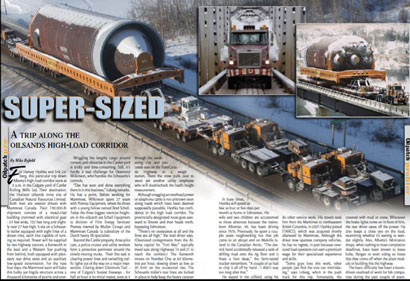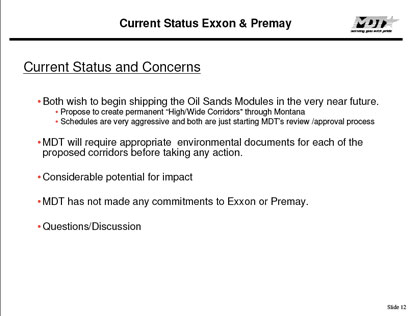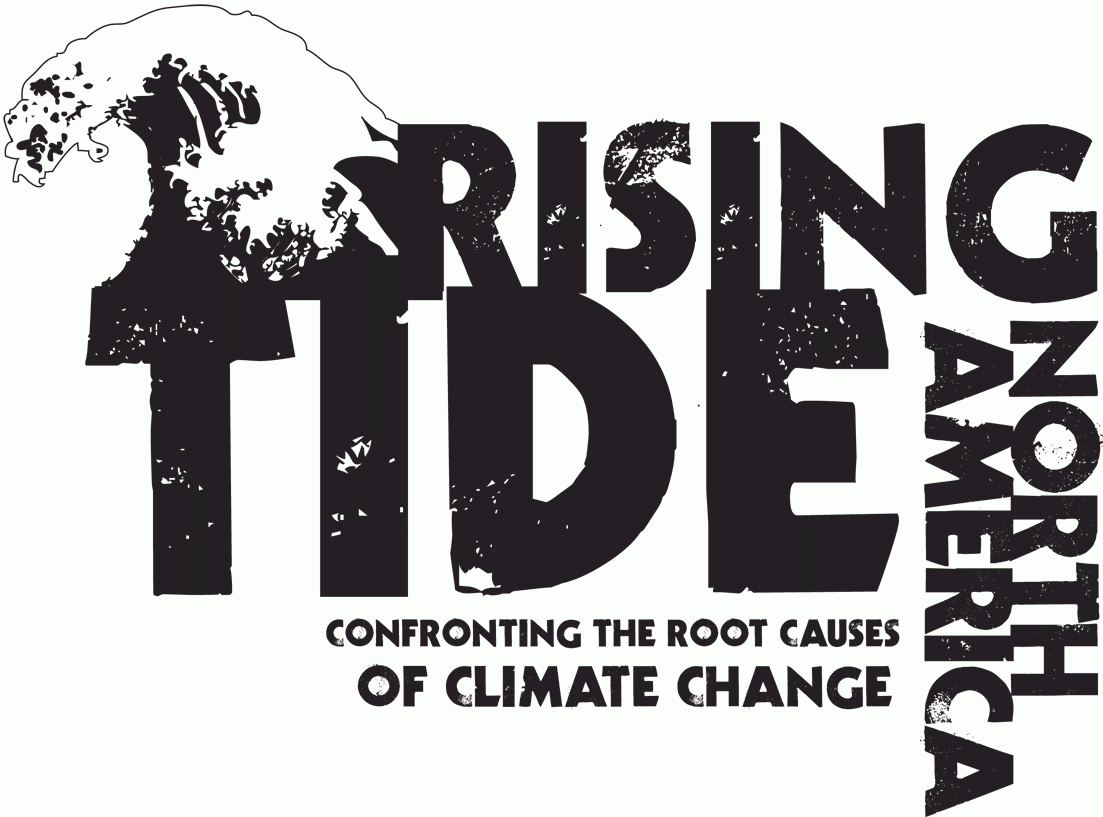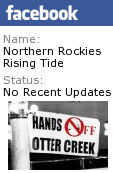The Globalizing of North American Colonialism
The inaugural International Tar Sands Resistance Summit (ITSRS) wrapped up near Missoula last Monday, November 22, with a packed house at the Missoula City Council meeting. As the first true snowstorm of the season coated the street outside, inside the council was voting unanimously to double the cost of hauling oversize loads through the city in reaction to community backlash against plans by oil sands companies to route equipment through Missoula.
The summit, hosted by NRRT and the Indigenous Environmental Network (IEN) at Lubrecht Experimental Forest, mere yards from the planned path of the mammoth shipments along MT Highway 200; brought together nearly 100 activists from around the US and Canada who are concerned about tar sands development.
Workshops about tar sands issues and trainings in a diversity of tactics for resisting the industry’s growth helped connect the dots between anti-tar sands struggles in places from Oklahoma, to Montana, to northern British Columbia and elsewhere. Speakers from communities impacted by tar sands infrastructure painted an unfortunate picture depicting a (black) gold rush in the heart of Canada with global implications. While the eyes of the world are on the oil wars in southwest Asia, a corporate-state free-for-all is spanning North America, with Ft. McMurray, AB at “Ground Zero”.
Rapid Expansion
The exploitation of Alberta’s bitumen (tar sand) deposits has been growing at staggering rates in recent years and foreign investment in the industry continues to swell. Private oil companies from western Europe and the US to national oil companies from eastern Asia are buying up stake in Canada’s tar sands as supplies of conventional “sweet crude” around the world begin to dry up. Facilitating this land-grab is a cross-continental network of pipelines and shipping corridors with which to import toxic chemicals and Brobdingnagian equipment, and to export oil to the highest bidders in the rest of the world.
The Gulf of Mexico Connection
As the largest marine oil spill in global history was dominating news headlines, many looked to the tar sands to the north as an alternative to off shore drilling. With Canada already contributing more oil to the US than any other country in the world, and the North American Free Trade Agreement (NAFTA) locking Canada into an energy pact that guaranteed a minimum percentage of that country’s oil production flowing across its southern border, the United States tapped its own “wells” directly into the oil fields of Alberta. Wells in the form of pipelines.
 All angled towards the tar sands region near Edmonton, Alberta, a series of pipes up to 3ft wide criss-cross the border, feeding America’s addiction to oil. In fact, the US has tapped into the Canadian supply so much that Canada can’t keep up. Despite this fact, Canadian company TransCanada plans for the nearly 2000 mile long Keystone XL pipeline to connect the tar sands all the way to the Gulf of Mexico.
All angled towards the tar sands region near Edmonton, Alberta, a series of pipes up to 3ft wide criss-cross the border, feeding America’s addiction to oil. In fact, the US has tapped into the Canadian supply so much that Canada can’t keep up. Despite this fact, Canadian company TransCanada plans for the nearly 2000 mile long Keystone XL pipeline to connect the tar sands all the way to the Gulf of Mexico.
Taking the land away… again.
The tar sands focused summit near Missoula was Oklahoma lawyer Harlan Hentges’ first excuse to visit the area. The harsh, wintry conditions in the mountains above Montana’s Blackfoot river and the laid back, left-coastish vibe of the Missoula-area population both proved to be a bit of a shock for the third-generation Oklahoman; though he welcomed both shocks with enthusiasm. Hentges’ comes from an area of northern Oklahoma known as the Cherokee Strip, named after the record setting run on land formerly promised by the US to the Cherokee Nation after the Trail of Tears, but which was opened by the US to white settlement in 1893. His family has been ranching cattle there since they claimed their 160 acres in the run.
“I’m a country boy,” he says, “so I have a strong connection to the land and understand what it means to owners.”
Farmers and ranchers all through the central plains are tied to more than their land. They are tied to what’s under it too. The Ogallala aquifer is the lifeblood of America’s heartland, supplying a source of irrigation for 27% of US agriculture and drinking water for 2 million people. The Keystone XL pipeline is proposed to cross through the shallow groundwater source, worrying environmental groups that oil leaking from the pipe could have tragic consequences. Adding to this danger is the fact that the pipe is to be built with thinner than normal pipe walls.
“When someone calls me they are concerned about one of two things,” says Hentges, who specializes in rural landowner’s issues. “They either want to stop someone from taking away their land, or they want to stop someone from polluting it.”
 These days that land-threatening someone happens to be TransCanada. The Canadian oil-services company is trying to use the rule of eminent domain to acquire the rights-of-way it needs to run the Keystone XL down to the Gulf Coast refineries of Port Arthur, Texas. The US government is once again taking land away from residents of the Cherokee Strip, Native and settler alike, and handing it over to a colonizer who doesn’t even want to live there. Landowners are desperate to stop the Keystone XL, for fear that their generations-old way of life in the region is coming to an end. Hentges remarked that in this battle against the tar sands, the environmentalists and the property-rights folks want the same thing. “They just don’t usually know it,” he said.
These days that land-threatening someone happens to be TransCanada. The Canadian oil-services company is trying to use the rule of eminent domain to acquire the rights-of-way it needs to run the Keystone XL down to the Gulf Coast refineries of Port Arthur, Texas. The US government is once again taking land away from residents of the Cherokee Strip, Native and settler alike, and handing it over to a colonizer who doesn’t even want to live there. Landowners are desperate to stop the Keystone XL, for fear that their generations-old way of life in the region is coming to an end. Hentges remarked that in this battle against the tar sands, the environmentalists and the property-rights folks want the same thing. “They just don’t usually know it,” he said.
Oil’s Northwest Passage
The ranchers of Oklahoma have even more in common with North America’s First Nations than a hot potato of broken promises on prairie land. 1800 miles away, British Columbia’s indigenous communities have voiced a resounding NO to plans by another tar sands company, Enbridge, to cross 700 miles of unceded coastal territory; in an effort to connect the oil supplies of northern Alberta to the Pacific Ocean. Enbridge’s Northern Gateway pipeline would bring natural gas condensate, a chemical used to slurry bitumen, to the tar sands. A parallel pipe would bring that slurry of synthetic oil from the tar sands to the deep-sea port of Kitimat, BC. The circuitous route of this proposed double-pipeline would send carcinogenic chemicals across three major watersheds and over a thousand streams, as well as the legitimate territories of some 50 non-consenting First Nations.
The Canadian Energy Pipeline Association has warned that the vast majority of pipeline ruptures occur due to “time-dependent failure such as external corrosion or stress corrosion cracking.” Meaning that it’s not a matter of if there is a spill from one of the two parallel pipelines, but when. In one ten-year period Enbridge reported spilling 132,000 barrels of oil in over 600 spills. Recent oil spills in Michigan, suburban Chicago and Salt Lake City could have been worse had they gone longer before being noticed. Much of the 1400 miles of pipeline in the Northern Gateway plan would be in isolated, difficult to access regions of a mountainous and biologically-sensitive temperate rain forest. Additionally, Enbridge has a history of neglecting safety measures that would have prevented spills, as was the case in Michigan.
The risk of spills arises from more than just the pipelines, and residents of the region remember all too well the consequences their Alaskan neighbors dealt with after allowing Exxon to operate in Prince William Sound. The oil set to flow through the Northern Gateway is not meant to end its journey in the coastal town of Kitimat. Up to 225 oil tankers per year, with a capacity of 2 million barrels each, would be required to navigate some of the most dangerous coastal waters in the world. A 1990 Environment Canada analysis of the likelihood of tanker accidents occurring in Canadian waters concluded that “based on current [1990] levels of tanker traffic, Canada can expect over 100 small oil spills, about 10 moderate spills and at least one major spill offshore each year. A catastrophic spill (over 10,000 tonnes) may occur once every 15 years.” Click to see how a spill could affect BC coastal waters.

Ultra Large Crude Carriers are the largest ships on Earth.
Resistance to the Enbridge Northern Gateway project goes beyond First Nations. 80% of British Columbia’s population is believed to be opposed to oil tanker traffic on the province’s coast. Political players in Canada are fighting over both proposed and existing tanker moratoriums affecting BC’s coast.
A River Runs Through It
Why, if Canada’s Tar Sands can’t even keep up with demand for existing pipeline capacity, are oil companies spending billions to lay even more pipe? Tar Sands companies have no intention of leaving the pipes unfilled. The Canadian Association of Petroleum Producers expects oil production from the tar sands to more than double in the next 15 years. Currently, dozens of tar sand operations are planned or under construction in Alberta, with hundreds of other sites being explored for exploitation potential.
As the mining facilities become more numerous, they are also becoming larger. In a business that profits in direct proportion to its ability to move the most volume of Earth that it can, bigger is better. This applies to ordering parts, too.
Late in 2009, oil behemoth ExxonMobil quietly met with local governments in western Montana to promise great things for the small towns’ economies. The plan was to ship some 207 things politely called “modules” through the region. In exchange the company would spend a little money and build some parking lots, referred to as “turnouts”, in the middle of the forest. The modules turned out to be 500,000 lb Lego pieces of a new tar sand mine in Alberta.

A three-story high coke drum waits out an expensive legal battle in Idaho.
Perhaps in the offices of tar sand giants like Exxon or Conoco, in oil-friendly cities like Edmonton, Dallas or Billings; this sounded like a fine plan. But as with the settlers of the central plains, and the First Nations of the Pacific northwest, residents along the route of these shipments have a conflicting idea of what is good for them.
What is known today as US Hwy 12 in Idaho and western Montana, served first as the route of Meriwether Lewis and William Clark’s expedition to the Pacific. In their time, the expedition served as a catalyst in the lives of indigenous people already living there. So began over two centuries of illegal immigration into what in 1805 was still Indian country; first to exploit it for gold and firs, later to possess it for settlement.
Despite the legacy of colonialism in the northern Rockies, the river valleys of Idaho and Montana retain a resemblance to their pre-conquest conditions. Grizzlies and cougars still hunt these woods, salmon still spawn in the eddies. Missoula, MT, a small city of about 60,000 people, rubs against a federally designated wilderness area. Visitors to town are often treated to the sight of ospreys fishing the Clark Fork river right downtown.
 West across the 9000 ft Lolo pass from Missoula is the Lochsa and Clearwater rivers in Idaho. Tourism is the leading industry, drawing $150 million into the region’s economy. US12, the windy, two-lane mountain road through the area, is dotted with signs warning of wildlife crossings and rock slides. Mom and pop lodging establishments cater to whitewater rafters, hunters and cross-country skiers.
West across the 9000 ft Lolo pass from Missoula is the Lochsa and Clearwater rivers in Idaho. Tourism is the leading industry, drawing $150 million into the region’s economy. US12, the windy, two-lane mountain road through the area, is dotted with signs warning of wildlife crossings and rock slides. Mom and pop lodging establishments cater to whitewater rafters, hunters and cross-country skiers.
When Exxon began staging hearings along the route about their project, they were confronted by a population more concerned with protecting their communities and the land those communities rely on, than with accommodating outsiders with a far away agenda. Injunctions, resolutions and ordinances against the tar sands heavy-hauls began keeping the modules trapped at the Port of Lewiston, costing the oil giants millions of dollars.
As much as the scenery of the northern Rockies invokes the inner environmentalist in some, so too does the region’s distance from the alienation of large cities invoke in others a demand to be seen and heard by global interests. David is forcing Goliath to look him in the eye.
The Problem of “Foreign” Oil
Perhaps Manifest Destiny and post-WWII economic might had trained many Americans to expect to always be at the top of the economic food-chain, but for folks in this neck of the woods it seems other influences are calling the shots. The introduction of the tar sands shipping corridor through Idaho and Montana introduced a lot of area residents to corporations they had never heard of before: Imperial, Harvest, Sung Jin, Mammoet.
 The major players in Big Oil today do not hail from just Texas. State-controlled oil companies from Europe and Asia have invested billions in Alberta’s tar sands in recent years. Global production of crude oil is falling and demand is rising; and oil-hungry countries desperately clinging to the false-progress of industrialization are scrambling to control the last of the world’s reserves. And just like the divvying-up of the Americas after Cristoforo Colombo got lost on his way to Japan, and the parceling out of Indian territory after US independence; the world’s wealthiest states are dividing up the last supplies of the most sought after drug on Earth without regard for the people in their way.
The major players in Big Oil today do not hail from just Texas. State-controlled oil companies from Europe and Asia have invested billions in Alberta’s tar sands in recent years. Global production of crude oil is falling and demand is rising; and oil-hungry countries desperately clinging to the false-progress of industrialization are scrambling to control the last of the world’s reserves. And just like the divvying-up of the Americas after Cristoforo Colombo got lost on his way to Japan, and the parceling out of Indian territory after US independence; the world’s wealthiest states are dividing up the last supplies of the most sought after drug on Earth without regard for the people in their way.
In particular addition to US and European corporate investment are the emerging powerhouse economies of eastern Asia. China is buying up as much control over Canada’s tar sands as they can get away with. Korea is taking over tar sand contracts from manufacturing to shipping, as well as operations in Canada itself, leaving US and Canadian companies in the dust and the world’s civilizations thirsting for more.
A New Wave of Colonists
Marty Cobenais is an organizer with the Indigenous Environmental Network, co-sponsor of the International Tar Sands Resistance Summit. He’s been working with communities along the Keystone XL’s route for the last two years, trying to prevent oil and gas companies from destroying land-based people’s homes from Canada to the Gulf of Mexico. The Alberta Clipper oil pipeline passes just two miles from his office in northern Minnesota.
At the ITSRS in the mountains of Montana, Cobenais had few reservations about the strength of his words against the Tar Sands. He feels he is fighting a war.
“You know the old military strategy of cutting off the supply chain?” Cobenais says about the burgeoning heavy-haul corridor through Montana, “Montana is the supply chain.”
He and his relations have been resisting the colonization of his country by European settlers for hundreds of years. Now even those settlers are finding themselves under the work-boots of a new wave of colonists marching to and from the Alberta Tar Sands and are joining forces to defeat a common threat.
Northern Rockies Rising Tide wishes to extend a special Thank You to the Indigenous Environmental Network and Peaceful Uprising, co-sponsors of the inaugural International Tar Sands Resistance Summit 2010. (Peaceful Uprising is spearheading the campaign against the PR Springs mine in eastern Utah. PR Springs is slated to become the first commercial scale tar sand operation in the United States.)
NRRT would also like to thank all of the presenters, trainers and attendees of the ITSRS 2010; caterers Seeds of Peace, and gracious host Lubrecht Experimental Forest.




















